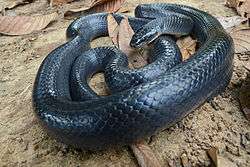Mussurana
| Mussurana | |
|---|---|
 | |
| Scientific classification | |
| Kingdom: | Animalia |
| Phylum: | Chordata |
| Subphylum: | Vertebrata |
| Class: | Reptilia |
| Order: | Squamata |
| Suborder: | Serpentes |
| Family: | Colubridae |
| Subfamily: | Xenodontinae |
| Genus: | Clelia Fitzinger, 1826 |
| Species | |
|
Clelia bicolor | |
The mussurana or musurana (Portuguese muçurana) is a genus (Clelia) of colubrid snakes found in Central America and South America, from Guatemala to Brazil. They specialize in ophiophagy, i.e., they attack and eat other snakes. Currently six species are recognized.[1] They have other popular names in various countries, such as zopilota in Central America and cribo on some Caribbean islands (though they are not related to Drymarchon).
Species
The following species are currently recognized:[1]
- Clelia bicolor (Peracca, 1904)
- Clelia clelia (Daudin, 1803) (also called Pseudoboa clelia – Serié, 1921; Pseudoboa occipitolutea – Serié, 1936; Boiruna maculata – Leynaud & Bucher, 1999)[2]
- Clelia equatoriana (Amaral, 1924)
- Clelia errabunda Underwood, 1993
- Clelia rustica (Cope, 1878)
- Clelia scytalina (Cope, 1867)
Description
The mussurana has an average length of 1.5–1.6 metres (4.9–5.2 ft), but it can grow up to 2.4 metres (7.9 ft). When young, its dorsal color is light pink, which becomes lead-blue when it is adult. The ventral color is whitish yellow. It has 10 to 15 strong teeth at the back of the mouth (opisthoglyphous teeth) which it uses to grasp the head of the attacked snake and push it into its gullet. Then it coils its body around the victim, killing it by constriction (this is the reason this species is called a pseudoboa). Ingestion of the whole body follows. The long body of the ingested snake is compressed as a wave in order to fit into the mussurana's gastrointestinal system. Mussaranas are oviparous.
Although mussuranas are rear-fanged and produce a mild venom, these snakes pose no danger to humans. Even when handled they usually do not bite. Very few envenomations have been reported and they were not fatal.
The mussurana is immune to the venom of the snakes it feeds upon, particularly the smaller Central and South American pit vipers of the genus Bothrops. It is not immune to the venom of the coral snake, though. In the absence of other snakes, the mussurana can feed also on small mammals. It has been reported that at least some captive specimens will accept only live snakes as prey. Its preferred habitat is dense ground-level vegetation and its habit is diurnal.
In some regions, farmers keep mussuranas as pets in order to keep their living environment clear of pit vipers, which claim annually a large number of deaths of domestic animals, like cattle. In the 1930s a Brazilian plan to breed and release large numbers of mussuranas for the control of pit vipers was tried but didn't work. The Butantan Institute in São Paulo, which specializes in the production of antivenins, erected a statue of Clelia clelia as its symbol and a tribute to its usefulness in combating venomous snake bites. The mussurana's immunity to bothropic venom was studied by the Brazilian scientist Vital Brazil in the 1920s.
Mussuranas are increasingly rare due to the disappearance of their prey and have disappeared in many habitats.
References
Further reading
Ditmars, R.L. 1936. The Reptiles of North America. Doubleday and Co., New York, NY, 476 pp., 135 plates. Notes: Trimorphodon, Leptodeira capable of poisonous bites; mentions boomslang, possibly mussurana, dangerous.
Roosevelt, Theodore 1914. Through the Brazilian Wilderness. New York: Charles Scribner’s Sons, 410 pp. Notes: Throughout the book, the snake is commonly referred to as the "mussurama".
External links
| Wikimedia Commons has media related to Clelia. |
| Wikispecies has information related to: Clelia |
- Mussurana Care Sheet
- Photograph from the wild: mussurana 1, common lancehead 0.
- discussion forum (about venom of musurana)